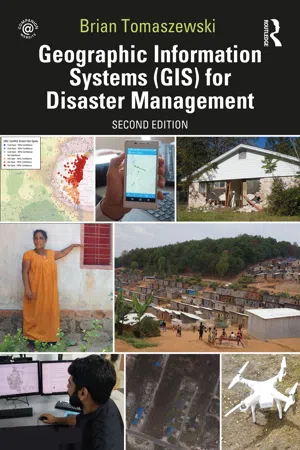
- 454 pages
- English
- ePUB (mobile friendly)
- Available on iOS & Android
Geographic Information Systems (GIS) for Disaster Management
About This Book
Now in its second edition, Geographic Information Systems (GIS) for Disaster Management has been completely updated to take account of new developments in the field.
Using a hands-on approach grounded in relevant GIS and disaster management theory and practice, this textbook continues the tradition of the benchmark first edition, providing coverage of GIS fundamentals applied to disaster management. Real-life case studies demonstrate GIS concepts and their applicability to the full disaster management cycle. The learning-by-example approach helps readers see how GIS for disaster management operates at local, state, national, and international scales through government, the private sector, non?governmental organizations, and volunteer groups.
New in the second edition:
- a chapter on allied technologies that includes remote sensing, Global Positioning Systems (GPS), indoor navigation, and Unmanned Aerial Systems (UAS);
- thirteen new technical exercises that supplement theoretical and practical chapter discussions and fully reinforce concepts learned;
- enhanced boxed text and other pedagogical features to give readers even more practical advice;
- examination of new forms of world?wide disaster faced by society;
- discussion of new commercial and open-source GIS technology and techniques such as machine learning and the Internet of Things;
- new interviews with subject-matter and industry experts on GIS for disaster management in the US and abroad;
- new career advice on getting a first job in the industry.
Learned yet accessible, Geographic Information Systems (GIS) for Disaster Management continues to be a valuable teaching tool for undergraduate and graduate instructors in the disaster management and GIS fields, as well as disaster management and humanitarian professionals.
Please visit http://gisfordisastermanagement.com to view supplemental material such as slides and hands-on exercise video walkthroughs. This companion website offers valuable hands-on experience applying concepts to practice.
Frequently asked questions
Information
1
A Survey of GIS for Disaster Management
Chapter Objectives
- 1. understand the role of maps in disaster management;
- 2. describe how maps provide geographic context for disaster management and recognize how geographic information systems (GIS) can be used for understanding geographic context;
- 3. be familiar with the concept of situation awareness;
- 4. discern the problems associated with the continued need for GIS in disaster management;
- 5. recognize the opportunities that exist with continued awareness and advocacy of GIS and mapping for disaster management;
- 6. understand the importance of spatial thinking in disaster-management practice.
Introduction
- (1) scientific principles of geographic data and information;
- (2) how those principles apply to specific GIS software;
- (3) what GIS, related mapping software, and allied technologies can and cannot do in terms of supporting disaster management practice;
- (4) how GIS relates to various disaster-management cycle phases;
- (5) ideas for keeping abreast of the ever-changing world of the application of GIS to disaster management.
GIS and Geographical Context

- What is the extent of the flood?
- What are the number of people impacted by the disaster?
- What are the environmental processes at work in an area that are needed for mitigating the effects of a storm surge?
- What is the status of the movement of relief supplies?
- What resources are available for disaster-planning purposes?
- How did an area become vulnerable to a disaster?
- Why were the impacts from a disaster greater in one area compared to another?
- How well will a disaster plan actually work in practice?
- Why were there problems with the disaster response?
- How can the effects of a natural hazard best be mitigated in a physical environment?
- Why was recovery in one area slower than in another area?

Table of contents
- Cover
- Endorsements
- Half-Title
- Title
- Copyright
- Dedication
- Contents
- Preface
- Acknowledgments
- Technical Exercise Notes
- 1 A Survey of GIS for Disaster Management
- 2 Fundamentals of Geographic Information and Maps
- 4 Geographic Information Systems and Allied Technologies
- 5 Disaster Management and Geographic Information Systems
- 6 Geographic Information Systems and Disaster Planning and Preparedness
- 7 Geographic Information Systems and Disaster Response
- 8 Geographic Information Systems and Disaster Recovery
- 9 Geographic Information Systems and Disaster Mitigation
- 10 Special Topics, Future Technology, Professional Career Options, and Geographic Information Systems Trends
- Index